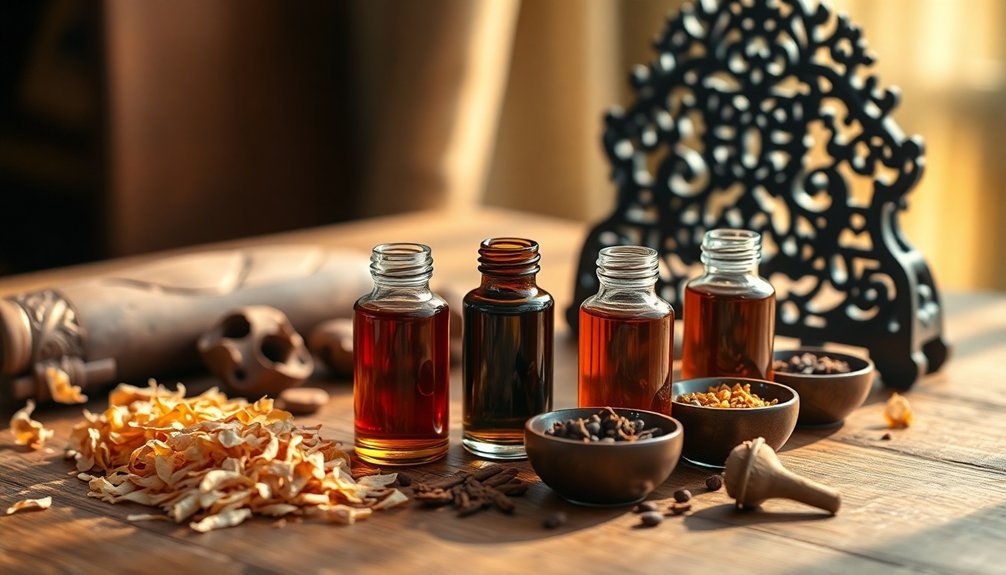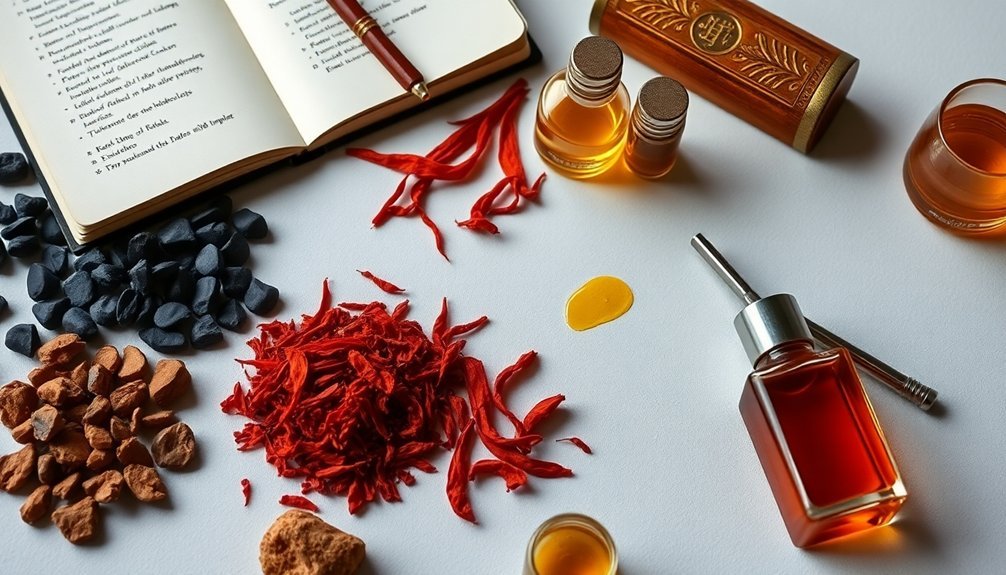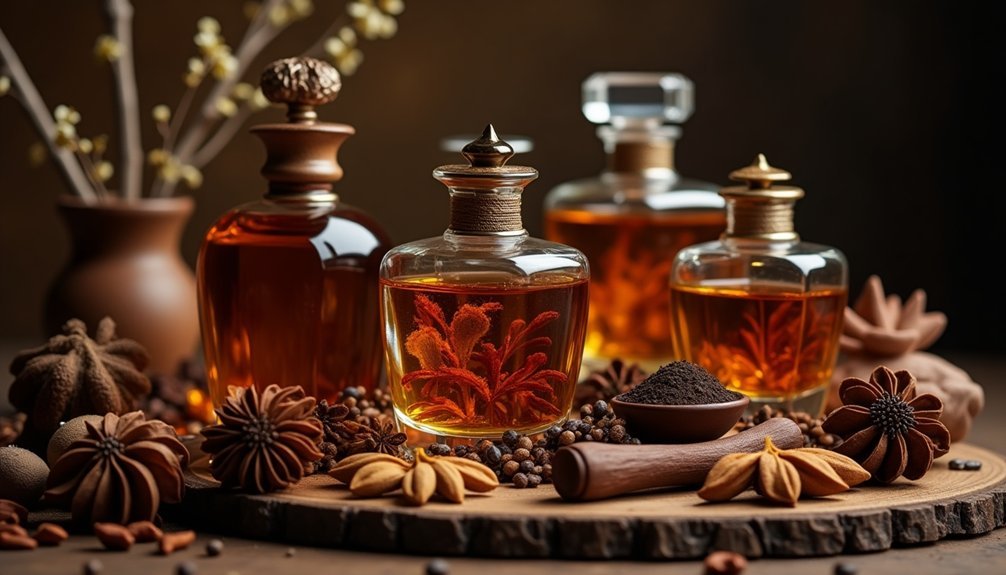You'll master woody oriental perfumery by starting with a strong sandalwood or cedarwood base at 30-40% of your composition. Layer in oud or vetiver at 15-20% for depth, then add resinous notes like frankincense at 15-20%. Balance these with warm spices at 10-15% and subtle florals at 5-10%. Follow the classic 30-50-20 ratio of top, middle, and base notes. The intricate dance between deep woods and oriental elements awaits your expert touch.
Understanding Core Woody Oriental Elements

When crafting woody oriental fragrances, you'll need to master two fundamental pillars: the deep, resonant woody notes and the rich oriental elements that form the foundation of these complex scents.
Start with sandalwood's creamy warmth or patchouli's earthy depth as your woody base. You'll find that vetiver adds smoky richness, while cedarwood brings a dry, linear quality. These woody notes provide reassurance and structure to your composition. For luxury and complexity, consider incorporating oudh.
Then, layer your oriental elements strategically – vanilla and tonka bean offer sweetness and elegance, while labdanum contributes leathery intensity. Ambergris can elevate your blend with its luxurious character.
To achieve balance, you'll want to understand how these elements interact. The woody notes provide structure, while the oriental ingredients add depth and sensuality, creating that signature opulent character that defines the category.
Essential Notes Selection and Proportions
Selecting the right notes and proportions forms the cornerstone of creating successful woody oriental fragrances.
You'll want to start with a strong woody base, using sandalwood or cedarwood at 30-40% of your composition. Layer in oud or vetiver at 15-20% for depth and complexity. These woody notes serve as excellent base note anchors that provide lasting power to your fragrance.
Add resinous notes like frankincense or myrrh at 15-20% to create that signature oriental character. Spices should make up 10-15% – try cinnamon or clove to add warmth.
For the top notes, use floral elements sparingly at 5-10%, focusing on rich varieties like rose or jasmine. Finally, incorporate musks at 5-10% to bind everything together and add longevity to your creation.
Remember that these proportions aren't rigid rules but rather starting points for your experimentation.
Proven Blending Techniques and Ratios

After mastering note selection and proportions, the next challenge lies in understanding proven blending techniques that bring your fragrance vision to life.
You'll find success with three primary methods: the Neighbour technique pairs adjacent subfamilies like rose and bergamot, the Opposite technique combines contrasting notes like pine and lime, and the Triangle technique creates complexity by blending three distinct subfamilies.
For ideal results, follow the classic 30-50-20 ratio of top, middle, and base notes. Start small with 5-15 drops, and let your blend mature for several days.
When working with woody orientals specifically, you'll want to pair woods like sandalwood with spices and amber for depth, or combine them with florals for sophistication. The rich and exotic qualities of oriental scents add an element of mystery to woody blends.
These techniques guarantee balanced, long-lasting fragrances that capture your intended scent profile.
Base Structure Development and Layering
The foundation of any exceptional fragrance lies in its base structure, where De Laire bases and woody notes play essential roles in creating depth and longevity.
You'll find these complex pre-made accords invaluable for building sophisticated fragrances while simplifying your creative process.
When developing your base structure, start by selecting appropriate woody notes – whether dry, mossy, resinous, or creamy – to anchor your composition.
You can blend sandalwood for a smooth foundation or oud for intense complexity.
Layer these with De Laire bases to achieve specific olfactory effects while ensuring regulatory compliance and batch consistency.
Professional Adjustments and Refinements

Making professional adjustments to your fragrance formulation requires both technical expertise and artistic sensitivity.
You'll need to carefully calibrate ingredient proportions while maintaining clear communication with your client throughout the refinement process.
- Document every modification you make to the formulation, tracking how different combinations affect the overall scent profile.
- Perform regular stability tests to guarantee your adjustments don't compromise the fragrance's integrity or longevity.
- Conduct thorough quality control checks after each significant change, including sensory evaluations and chemical analysis.
- Use advanced formulation tools to maintain precise measurements while experimenting with new note combinations.
Remember to keep detailed records of your experiments and maintain open dialogue with your client about any adjustments.
This systematic approach will help you achieve the perfect balance of notes while meeting quality standards and client expectations.
Frequently Asked Questions
Can Woody Oriental Fragrances Trigger Allergic Reactions in Sensitive Individuals?
Yes, you can experience allergic reactions to woody oriental fragrances, as they often contain common allergens like essential oils, fragrance mixes, and specific compounds that may trigger skin sensitivities or allergic responses.
How Long Does a Properly Blended Woody Oriental Fragrance Typically Last?
You'll typically experience 8-12 hours of wear from a well-blended woody oriental fragrance. With proper application on moisturized skin and rich base notes, you can expect the scent to last throughout your day.
What Temperature Conditions Are Best for Storing Woody Oriental Perfume Blends?
You'll want to store your woody oriental perfumes at room temperature between 15-25°C. Keep them in a stable environment away from temperature fluctuations, direct sunlight, and heat sources to preserve their rich fragrance notes.
Are Natural or Synthetic Ingredients Better for Creating Woody Oriental Scents?
You'll find both natural and synthetic ingredients have their merits. Natural ingredients offer authenticity and complexity, while synthetics provide consistency and longevity. For the best woody oriental scents, consider using a balanced combination of both.
Can Woody Oriental Fragrances Be Effectively Used in Reed Diffusers?
Yes, you'll find woody oriental fragrances work excellently in reed diffusers. They diffuse steadily, maintain their complex notes well, and last 8-12 weeks. Just remember to flip your reeds weekly for best results.
In Summary
You've now learned the key aspects of blending woody oriental fragrances, from selecting core notes to mastering professional refinements. Armed with essential ratios, proven techniques, and layering methods, you're ready to create sophisticated compositions. Remember to trust your nose while following these guidelines, and don't be afraid to experiment. Your journey into crafting rich woody orientals has just begun.





Leave a Reply